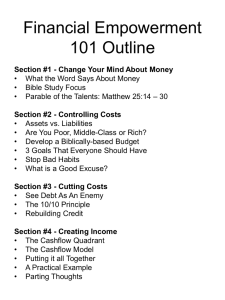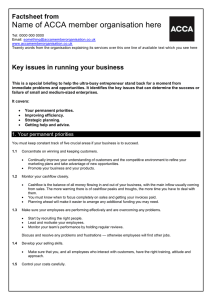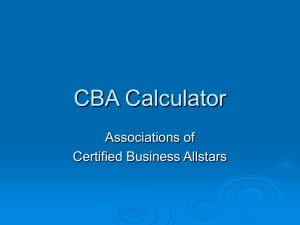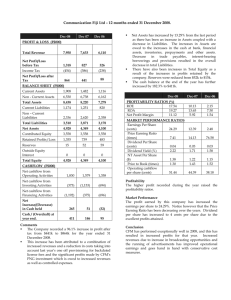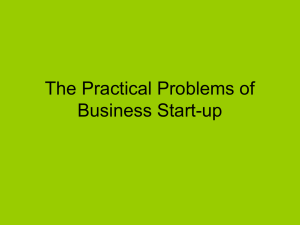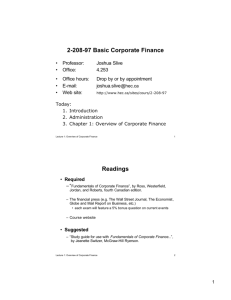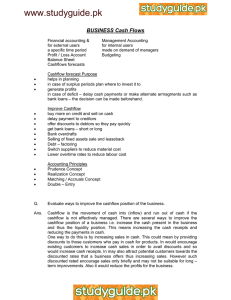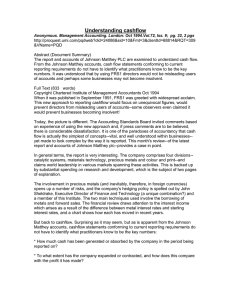Short questions
advertisement
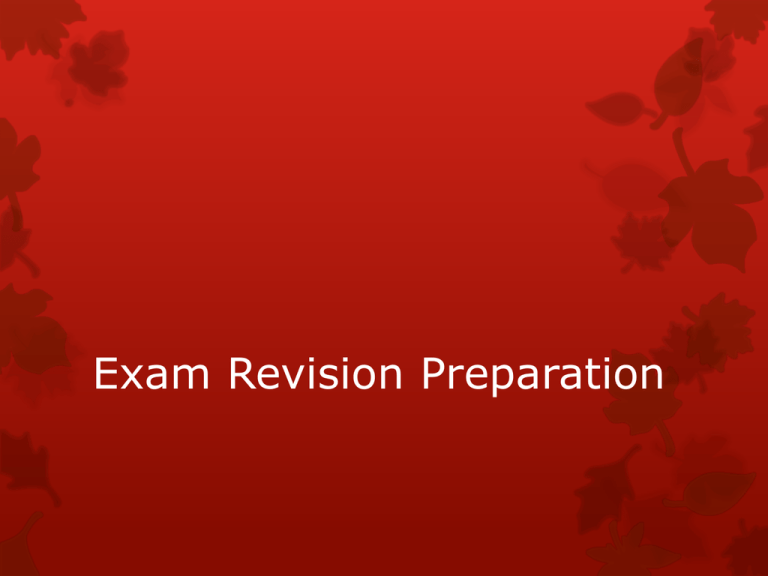
Exam Revision Preparation Sec 1 Short questions Worth 20% of exam, do first! Its vital you know all the terms from across the course One sentence answers are not enough. Its wise to split all definitions into two separate points and ensure the information is relevant the specific way the question was asked. Think before you write, you only have 4 lines, part one definition second part could be advantage/disadvantage or fully explained example Only spend 30 minutes on this section, if you have time do all 10 you’ll get marked on the best Section 2 ABQ Worth 20% Spend no more than 36/40 minutes on this section In 2016 the ABQ will be based on units 3, 4 and 5 There are 3 questions based on a given passage, one point from each unit. You must state your point, expand the point and related it to the text Course knowledge dictates the marks and the links only have a supporting role An isolated link without knowledge is never awarded marks Read the questions first then the case so you’ll know what you are looking for State means you must have a heading Explain the point with two separate sentences (“this means…, extra sentence may be evaluating/or advantages/disadvantages, give your opinion. Example, is a quote from the story that shows the relevance of your point Section 3 Long Questions 60 Mark questions Do 4 long questions spending no more than 25 minutes on each question Unit 1 To date question 1 has been from unit 1 Parties in a business (entrepreneur, investor, producer, consumer, employer, employee, service provider, government and society, interest groups) Relationships, co-operative and competitive Law of contract (elements, how to end a contract, remedies for breach) Legislative methods of conflict resolution Non legislative methods of conflict resolution Unit 2 This is a short section but has been used as a 60 mark in the past Characteristics and skills of an entrepreneur Enterprise skills in home, community, school, government and business Intrepreneurship Unit 3 must be able to define each management skill and activity Evaluation means “in my opinion”, make a comment or judgement to back up your opinion 1. Leadership, autocratic, democratic laissez-faire, what are they and a result of each style with an example Include directing and co-ordinating as part of leading Know the link with delegation and in particular the span of control; definition and diagram and chain of command 2. Motivation, definition, how to improve motivation, Maslow's hierarchy, why its important and how a manager can satisfy needs McGregor, be able to distinguish between theory X and Y 3. Communication, definition and importance, types e.g. up and down, principles of good communication Barriers to effective communication Factors when deciding on an effective method of communication Layout of memo, business, letter, report Visual communication include the drawing of diagrams Communication and technology Unit 3 management activities 1. Planning, why it’s the most important activity, including examples Objectives Roles of SWOT analysis (have a prepared example) Mission statement Types of planning, strategic, tactical, contingency and link to the benefits of planning 2. Organising Draw, label and explain all org. structure. Be able to discuss the benefits of each structure Define and draw a span of control Delegation and factors affecting span of control 3. Controlling Define, principles, Types; stock, credit, cash, quality cost (know a basic definition of each control type Unit 4 key areas are household and business manager o Similarities and difference between managing a household and a business in areas of tax insurance and finance. CASHFLOW FORECAST; 1.How to analyse a cashflow e.g. capital expenditure usual causes of liquidity problems 2. Purpose or benefits of a cashflow forecast named and explained 3. Household cashflow vs. business cashflow 4. matching a source of finance with a need e.g. Mortgage, know one example for each type of finance, short, medium, long, bank overdraft, hire purchase, equity shares INSURANCE; Principles (5 basic) Average clause application and explanation remember to link to indemnity. Relationship between risk and premium, overlap with risk management a planned approach. Strategies to reduce risk (insurance, health and safety, and be able to discuss either fully) Household policies and business policies TAXATION; Types of income tax including Tax forms P12, P21, P45 and P60, How to calculate net pay using tax credits and self assessment. Business taxes; recognise Corporation tax, Value Added Tax, Capital gains tax, capital acquisitions tax Unit 4 Continued Monitoring the business; know how to analyse a basic Trading P&L a?c and Balance sheet. Know the key terms e.g. current assets/liabilities, closing stock, Sales-less cost of sales = gross profit, GP less expenses=Net profit. Know the importance of financial information and the users of financial information (employees look at profits, suppliers look at cashflow, investors look at capital structure). Spread sheet uses, advantages of low gearing, relationship between debt and equity, advantages of high gearing, know how to apply 6 ratio and comment on the trend under the following headings 1 profitability, Gross margin, Net margin, Return on investment 2 Liquidity (:) Current ratio, acid test ratio Capital Structure (:) Debt to equity Unit 5 Identifying Opportunities INTERNAL AND EXTERNAL sources of opportunities/ideas New product/service development process,(key that they are in the correct order) MARKETING; concept (customer focus) Marketing strategy the benefits of the plan and its parts, Developing the marketing mix, know each aspect of the individual P’s GETTING STARTED finance, ownership, business plan, start up factors and challenges. EXPANSION reasons name and explain, finance debt and equity, implications and methods of expansion, benefits of mergers and takeovers and risks involved, alliances and franchises. Unit 6 CATEGORIES OF INDUSTRY, agri manufacturing, services, and natural resources. Know 3 good definitions plus the contribution to the Irish economy. TYPES OF BUSINESS ORGANISATION choosing between alternatives, sole trader, partnership, private limited company PLC TNC co-op, state owned, indigenous. Know pros and cons of each. Changing trends in ownership and structure, why they would change from one type to another. Remember that alliances and Franchises can be asked from here or unit 5 COMMUNITY DEVELOPMENT, local community and business, county enterprise board/Fás/Area partnership. Companies are the only organisation s relevant in this section. Community development incorporating local community initiatives. Use words like local, self-help social and economic in this chapter Unit 6 cont; BUSINESS AND THE ECONOMY; the impact of the economy on business, taking into account the general state of the economy, inflation, interest taxes, tax and grants. Use a table with definition and the impact on the business. The impact of business on the economy at local and national level, taking into account employment, tax revenues and environmental issues. The interaction between business and the wider economy GOVERNMENT AND BUSINESS; an introduction to the governments' role in encouraging and regulating business(creating a suitable climate). Role of the government as employer. Social responsibilities of business; ethical business practice, socially responsible business at local and national level. Characteristics of an environmentally conscious firm. Costs and opportunities associated with doing the right thing. Unit 7 INTRODUCTION TO INTERNATIONAL TRADING ENVIRONMENT; the significance of international trade for the Irish economy. Know the visible and invisible sections and balance of trade and balance of payments. The changing nature of the international economy and its effects on Irish business. Opportunities and challenges for Irish business in international trade. Trading blocs and agreement and an open economy. EUROPEAN UNION; the importance of the EU. The purpose of the main EU policies and directives & regulation and their impact on Irish business 1 agricultural, 2 fisheries, 3 competition, 4 social, 5 economic and monetary International business; the global marketing of products and services including the challenges. The development (reasons for coming here) and impact of transnational companies (corporation tax paid/jobs created/spinoff effect/payroll paid/types of companies). Key points Learn the material and test yourself regularly. Each question has 3 areas to look at as follows; Evaluate how the Sale of Goods and Supply of Services Act 1980 help protect the consumer. Evaluate (in my opinion) The Act Protecting the consumer All questions should be treated in a similar manner Almost all questions are State Explain the point using relevant knowledge from the course. Learn the course in bullet points, Quality revision means being able to rewrite the exact information unaided. In the long question, a minimum of one and a maximum of two questions must come from part one. Name Explain example or Evaluation (in red)
